| BUILDINGS & FACILITIES |
YEAR: 2010
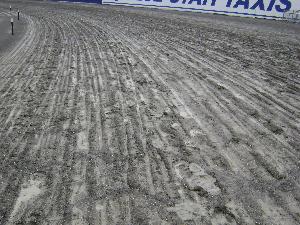 |
The Addington Raceway surface has been one of the most durable and consistent in the world over the last 30 years. For the first time in decades a meeting was called off (after the sixth race)at Addington Raceway last Friday night due to the state of the track after a day of rough weather.
Traditionally, the Addington track has remarkable drying and absorption qualities but on Friday night things were different. The writing was on the wall early when a false start was declared in the 2YO Non-Tote Trot due to the mobile gate being unable to gain satisfactory traction to clear the field at dispatch. Rolling starts ensued but the rain kept falling.
The track was awash, with drivers getting unusually muddy and visibility back in the fields being very limited. A meeting of senior horseman, Stipendiary Stewards and Addington officials after Race 6 resulted in the meeting being abandoned.
Addington Raceway CEO, Shane Gloury, offers a rundown of events. “Basically, it came down to abnormal and unusual rainfall that reacted differently with the track than the rain we are used to. We had two inches of swirling, misty drizzle that sat on top of the track rather than draining through it and down the surface toward the inside.
“There was talk that the track was ‘conditioned’ earlier in the day and week. That wasn’t the case. Our track manager John Denton prepared the track as if it was going to rain on race day. “Obviously, since last Friday night we’re looking at ways to ensure this doesn’t happen again.”
The Met club hasn’t shirked its obligation to owners over the abandonment, either. Connections of horses that did not get a run in races seven to 10 on Friday night, that haven’t already received a travel subsidy, will be compensated $100 per horse.
The Caduceus Club Mares’ Championship, for which Kiwi Ingenuity was hot favourite will now be run six days after the Breeders Stakes on February 18 and will coincide with the final day of the National Yearling Sales.
Credit: HRNZ 25Jan10
YEAR: 2009
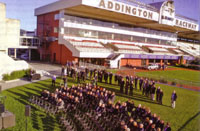 |
The new stabling complex at Addington Raceway, nestled in front and to the side of the Twiggers Stand, was opened to wide acclaim last Friday night.
The occasion was attended by senior administrators, club officials, horsemen and in the absence of the Minister of Racing, John Carter, who was detained in Wellington, the opening was performed by Pat O'Brien, the Chairman of Harness Racing New Zealand. From there on and throughout the night, there was heavy traffic through the building, all with favourable comment on the facility that is bright, roomy, quiet and convenient.
David Rankin, Chairman of the NZ Metropolitan Trotting Club, said the $7m state of the art complex "is without peer in the Southern Hemisphere. For decades our horsemen and women have operated from open facilities at the far end of the track in all kinds of weather, and have dreamed of the day they would get fully enclosed stables. As from today, all this changes. With the stables being so close to the Stewards' Stand, we will have a significantly enhanced team environment for owners, trainers, drivers, stipendiary stewards, vets, Addington staff, Board and Committee."
He said Addington is the most utilised track in New Zealand, with 57 racemeetings, 24 trials and workout meetings programmed for the next 12 months, in addition to about 73 greyhound meetings. Rankin said there may be some who question the financial wisdom of building them at all. "My answer to any critics is this: the location of the stables here has not only brought our stakeholders closer together, but left the old stabling area available for further development." He said there was over two hectares that can be redeveloped for club use and into income producing assets in a similar manner to the two-thirds share the club has in the joint venture along the back straight.
Rankin said there has been no detrimental affect on racing stakes as a result of increased costs for the stables. "The building of the new facility has not been without its share of challenges. The tight timeframe - between starting after the 2007 NZ Cup and having the roof deck finished in time for use a year later - meant that additional costs had to be incurred in meeting the conditions of Council which were not known at the start of construction. Then, in January 2009, the main building contractor experienced financial problems, ceased work, and was subsequently placed in liquidation."
The finished product is a high-quality complex of 156 stalls. The club is seeking sponsorship of each stall, which will be recognised by a plaque. They cost $500 for three years, or $3,000 for life. Already, one third have been sold.
Rankin said there are more plans ahead, including artificial grass on the stables deck, an upgrade of the ground floor of the Members stand, an upgrade of the area in front of the Public stand, modernising and landscaping the carparking and drive areas, and redevelopment of the Twiggers and Public stands.
Rankin acknowledged the work and efforts of numerous people and companies, including project managers, contractors, horsemen, staff and in particular the club's late Chairman John Penney who was a key instigator in the project.
Credit: Mike Grainger writing in HR Weekly 20May09
YEAR: 2007
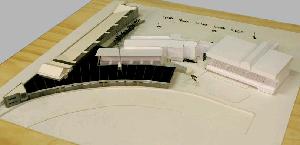 |
| A model of the proposed complex |
The NZ Metropolitan Trotting Club has received word from the NZ Racing Board approving funds for a new stabling area at Addington Raceway. This was received by the club's Chief Executive Officer, Mike Godber, on Monday.
The L-shaped complex will run along the front of the Twiggers Stand as far as the old Showgrounds boundary, and the right towards Lincoln Road. It means the Lindauer Lawn will be raised, the Pavillion removed and rebuilt once the stabling area has been constructed.
Godber said the work would not start until after the NZ Cup meeting in November. "But there is a lot of work that will happen between now and then, starting with resouce consents, permits, tenders and much else," he said.
Godber said the Club had been assisted with their planning by licenceholders Anthony Butt and Dave Anderson, and it would have room for 160 horses. "It is 5000 square metres, so it is a huge building," said Godber. The front section, in front of the stand, will cater for 70 horses, and there will be 70 in the Showgrounds wing. Provision has been made for the greyhound kennels on the Showgrounds bend. There will be a 1.2 metre walkway between the track and the front of the stand stabling area. As well as a swabbing area and washes, there is a 'secure' area for 15 horses.
The Lindauer lawn will not have grass as it has at present. That has to go, but exactly what will take its place is uncertain. "It could be artificial grass, or it could be a coloured rubber surface. That's something we will have to face later," he said.
The float park will shift to an area close to the stables, somewhere between the back of the Twiggers Stand and the Raceway offices. For the Cup Meeting, where parking is sold in that area, the floats will be quartered in the showgrounds.
Credit: Mike Grainger writing in HRWeekly 27Jun07
YEAR: 2000
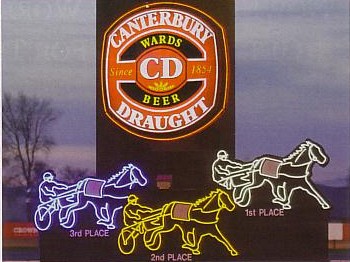 |
A new neon winning post was launched at Addington on Friday 15th September, 2000.
NZMTC Chairman of Racing, Barry Cotton, said that the new design would become an icon and instantly signal to both on and off-course punters that they were at Addington. "This unigue finishing post encapsulates the fun and excitment of harness racing at its best," said Cotton. "With all but two of our meetings being run at night, this colourful and innovative feature will be a real standout."
The new design is also a key branding exercise for Canterbury Draught, who wanted to establish a long-term branding opportunity for their red and black logo whe it became NZMTC's major sponsor. "By incorporating our logo into this unique and exciting finishing post, we can feature our brand to on and off-course punters," said South Island Regional Director, David Barley. "We also highlight that we are red and black - Canterbury!
The winning post features three horse/ sulky/ driver outlines, in white, yellow and electric blue, and immediately after each race these display the numbers of the horses filling the first three placings. The electronic software used is a World first, designed specifically for this sign.
Credit: Harness Racing Weekly 20Sep00
YEAR: 2000
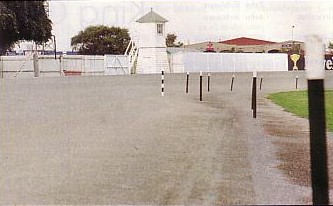 |
| Looking back towards the home turn |
The new, two-sulky passing lane will be in use for the first time at Addington on Friday night, 10th March 2000.
As a result of this, the track has been resurveyed with all starting positions altered by half a metre. An addition is a black and white sighter mark, which gives the drivers something to aim at.
"If the horsemen don't like it, we can take it out. That is no problem," said Mike Godber, the Metropolitan's Chief Executive Officer. He said the width of the lane is three metres, allowing room for two horses, and 250 metres of the track have been dedicated to the change.
This is the second introduction of the passing lane at Addington. It was tried for one meeting, in September 18 months ago
REVIEW:- Mike Grainger writing in HRWeekly 29Mar00
After just two meetings and 20 races, there are problems with the new passing lane at Addington Raceway. Driver have expressed their concern to Raceway officials. The officials agree, and promise to get it right. They will start with a meeting tomorrow between representatives of the Trainers and Drivers Association, Raceway directors and track engineers.
The issue for the drivers is not so much the passing lane but the camber of the bend and the transition leading into it. John Lischner, president of the trainers and Drivers Association, said the drivers considered Addington the best track in the world "but at present it is not. We thought they had two options, to take the passing lane in, which would have been the expensive way, or come out. This would have meant an alteration to the camber and taking the transition further down the track, to near the 2600m start. But we are not satisfied the camber on the corner into the staight is correct yet. We see good-driving horses lugging down on that corner and horses on the inside hitting the poles," he said.
Senior drivers Ken Barron and Kevin Townley insist the bend must be fixed. "It is going to be a real problem if it is left the way it is when the big races come round at Easter," said Barron. "I am very disappointed in it. You have to physically steer them round the top corner rather than allowing the horse to follow the natural contour and the transition finishes too quickly. It is similar to the one used for half a meeting about eighteen months ago. Anthony Butt said at a meeting we had with the Addington officials that if it is going to be done, do it right," he said.
Kevin Townley said: "It is not what we asked for; it's not right. We are having to drag horses up the camber and many on the inside are hitting the last pole," he said.
Mike Godber, Chief Executive Officer of Addington Raceway, says "I'm not happy with it. I know we have got a problem and it's got to be sorted out.I believe we have the best track and there is no compromise on that. We have got to maintain that standard."
Godber said officials had taken a number of comments from drivers to assist them rectify areas of concern. "Anthony Butt said the horses three and four wide on the corner were tightening those further down and that seems to be an accurate assessment of what is happening. The camber angle drops away too quickly.It should be able to be fixed," he said.
If it is not, Lischner said the likely alternative would be running the Easter meeting without the passing lane. Chief Stipendary Steward Neil Escott said: "I go along with the thoughts of the horsemen. Something will need to be done, especially with the Easter racing coming up. It would be unjust on the horsemen after raising the matter otherwise," he said.
Credit: Mike Grainger writing in HRWeekly 8Mar00
YEAR: 1994
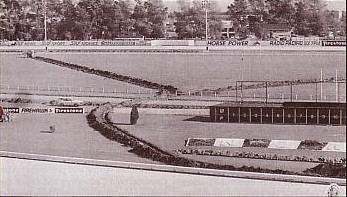 |
| Some of the trenching for the lighting cables. |
Work is well underway on the $1.4 million new lighting system for the track at Addington Raceway.
Mr Jack Hartley, chairman of the Raceway directors, says the system will be ready in time for the 1995 Inter-Dominion Championships. "The track will require 417 floodlights spread over 16 existing poles as well as using the roof of the members and stewards grandstand," he said.
The floodlights are being supplied by Versalux using General Electric 1500 watt metal halide floodlights. The work involves all the underground cabling being replaced and two new substations being installed. The average illuminance on the track will be five times greater than the current light level and at over 1200 lux, higher than any other track in New Zealand or Australia.
"There is a significant Canterbury involvement in the project which will boost the local economy by over $1 millon," said Hartley.
Credit: NZ HRWeekly 20Apr94
YEAR: 1992
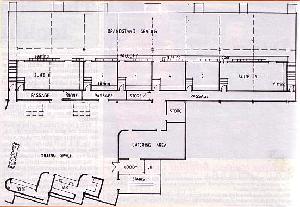 |
Work started this week on the construction of seven corporate hospitality suites at Addington Raceway. The completion date of the suites, on level three of the Twiggers Stand, is in late October. It will coincide with the refurbishing of the Gallery, which is the betting and bar area on the top floor of the stand.
According to Mr Mike Godber, Chief Executive Officer, the idea of corporate suites or private boxes at Addington, has been under consideration for quite a while. The total development of the area, says Mr Godber, will cost about $500,000.
The hire cost of a suite will vary, depending on the time of the year or the popularity of a particular race meeting. Six of them will accommodate 20 people and the other will hold 40. Already, two suites have been sold for the entire 1992-93 season. The suites will be built incorporating the best features from those in use at Lancaster Park and Riccarton. "There is a untapped market in this area," Mr Godber said.
Seven rows of seating from the top of the Twiggers Stand have been removed to provide space for the new extension.
Credit: Mike Grainger writing in HRWeekly 10Jun92
YEAR: 1990
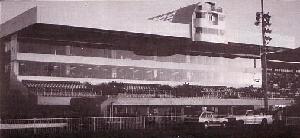 |
Addington Raceway's new Stewards' stand is finished. The stand was completed right on schedule - in time for this weekend's Easter Saturday meeting. The occasion will be marked by a short ceremony in the birdcage following race 2. Mr Jack Bennett, Chairman of the NZ Racing Authority, will offically open the complex.
"We have run on a bit of a wing and a prayer at the last minute with the hitches and little things left to do," says Addington's Chief Executive Officer, Mr Mike Godber. "But it's marvellous because the builders said they would be finished by Easter and they have," he said.
The stand was in use for the first two nights of the Easter Carnival last week, and Mr Godber says the general feedback has been tremendous. People have asked why we made each each floor so big and not divided it up. That's because we didn't want to make it into a rabbit warren; we can easily partition off separate areas if we need to," he said.
The new stand has stand $7.6m, which includes all inside furnishings and the building's exterior improvements. Over $250,000 worth of carpet (2500m˛) is laid throughout throughout the building, which also contains 800 chairs, 120 settees, 140 tables and 26 coffee tables worth the same amount. Nearly 50 video monitors are dotted throughout the four levels of the complex, and nine bars accommodate the thirsty patron's needs.
At ground level there is the Stipendiary Stewards room and waiting area, fees room, secretary's office, first aid room, a driver's room as well as separate areas for interviews and light meals. "The new birdcage is a third bigger than the old one, which brings the horses closer to the public in the main stand. The public area next to the birdcage is terraced so more people can see what is going on," Mr Godber said.
Over 500 seats flank the Lindores (first) floor, which includes a separate area for trainers and drivers to watch the races. Mr Godber says that each level will accommodate up to 600 people, which means that at a major meeting like Cup Day, over 2000 people could be comfortably in the building at one time. The second floor - Silks - is also for members. The difference between these two floors is the completely glassed front on the latter.
On both nights of racing last week, people experienced difficulty with reflections of lights and the video monitors when looking out onto the track. "It's a fact of life that any glassed-in area will have reflections from inside the building. There is no glass that won't reflect under the circumstances," he said. The third floor houses the Presidents Room, as well as his guests, the stewards, their guests, and sponsors.
In regards to the "relatively unused" areas around the escalators, Mr Godber stated that they are intended to give people room to move. "On the administration floor, people tend to mill around and we had to make that area big enough to allow for that. We made the other floors just as big because it would have looked silly otherwise. But they are also areas where people can get out of the hustle and bustle for a quiet sit down. Depending on the public reaction we have the option of installing totalisator and monitors out there as well," he said.
Coinciding with the opening of the stand is a new indicator board inside the track, the technology for which was developed by the TAB. "It is 100% better. The numbers that appear are made up of metallic strips painted with flourescent paint; the whole unit cost around $80,000. The possibilty of us having another board displaying sectional times is in the pipeline. He added that there was a possibility of having a counter running on all the monitor screens, similar to that seen during sporting events on television.
Credit: John Robinson writing in HRWeekly 11Apr90
YEAR: 1988
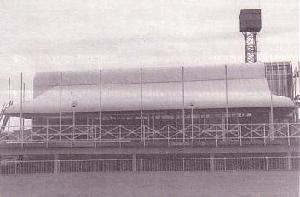 |
The Pavillion opened at the Canterbury Park TC's meeting on October 5, 1988.
The Pavillion replaced the marquee at the top of the straight, which had been used for the previous three years by sponsors and firms. The marquee had proved extremely popular, but strong winds had caused such damage that a permanent construction was necessary.
"The new variety is most impressive," said Trevor Davis, the Secretary-Manager of Addington Raceway. "Two walls are made completely of glass, so people don't have to go out onto the platform to watch a race. It has facilities that are designed for the function market. It can be hired out, just like Twiggers," he said.
The first sponsor to hire The Pavilion was the Merivale Mall.
Credit: NZ HRWeekly 5Oct88
YEAR: 1987
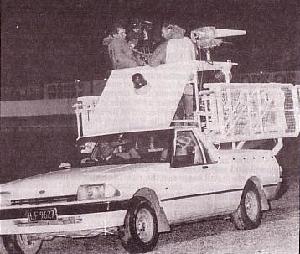 |
Television viewers were introduced to an innovative visual technique called "Trotcam" at Addington last Saturday. And such was it's popularity, it will be an intergral feature of Television NZ's Inter-Dominion coverage beginning on Saturday week.
Trotcam, a special camera mounted on the back of the mobile gate, was the brainchild of TVNZ senior cameraman Chris Stanbury and sports producer Doug McCammon.
The pictures Trotcam transmitted communicated a true impression of speed and excitement as the competitors swung in behind the mobile arm for the $75,000 TVNZ Mile. We saw Our Mana bumping keenly against the meshed grill, under a strong hold fron trainer/driver Colin De Filippi, and we saw the eventual winner Cinimod Junior lope lazily into his handy front row draw. This was "live" harness racing, not a dead spectacle filmed at medium range from the grandstand.
Stanbury told the Weekly Trotcam had long been an idea he wanted to see used for covering feature harness races, but, until now, technology had been the obstacle. "It's something we've been thinking about for several years - I saw it done at the Brisbane Inter-Dominions last year - but we haven't had the technology to do it. Cameras always needed to have a cable to send signals back to the control van, but now we use a transmitting receiver called a "golden rod" to send the signals through the air."
Stanbury and his workmates modified the utility tray of the mobile, cutting a hole in the roof and mounting the camera. "We were originally going to sit a cameraman on the roof, but it was so high it would have been very unsafe going around the corners," he said.
Permission to use the mobile was quickly given by club officials, the starter and stipendiary stewards, and the TVNZ crew used Addington trials to test the camera. Trotcam will be one of nine cameras TVNZ will have at Addington during the Inter-Dominion carnival, and the ground crew will number at least 30. "We tried a few new ideas (last Saturday) and what you saw was a scaled-down version of what you will see in the Inter-Dominions. It's going to look excellent," Stanbury said.
Credit: Matt Conway writing in HRWeekly 19Feb87
| << PREVIOUS | 1 2 3 4 | NEXT >> |